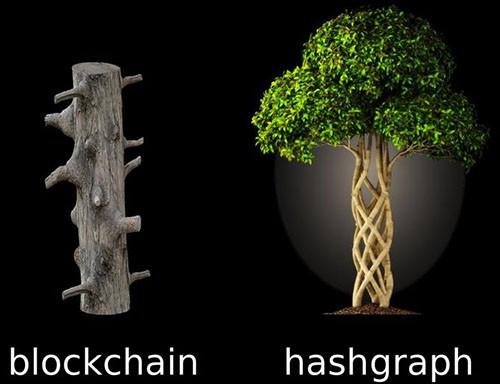While everyone is focused on Bitcoin and other blockchains, there’s a relatively new kid on the block that claims it will not only improve on the blockchain, but revolutionize the whole concept of decentralized consensus, and the internet as well while at it.
That claim is coming from Hashgraphs, one of the newest directed acrylic graph (DAG) platforms. Created by Leemon Baird of the company Swirlds, the technology was released on a new platform by Hedera Hashgraph in late March, and the general consensus in the cryptocurrency industry is that Hashgraph can make good on its promise to revolution decentralized consensus.
Until recently Hashgraph hadn’t garnered much attention, and when it did it was simply to highlight features that make Hashgraph different from blockchain, but there was little discussion of why it mattered. This has changed as Bitcoin suffered through the SegWit2X controversy, and as the scalability issue of blockchain persists. And of course the launch of the Hedera Hashgraph has brought this technology further into the limelight recently.
With all of this going on, I want to take a deeper look at the Hashgraph concept to see if it’s really something that can make blockchain obsolete. Below is what I learned and what makes it possible for Hashgraph to take the lead in decentralized consensus ledger technology.
Here’s Where Blockchain Technology is Lacking
Image via Fotolia
We’re going to talk about Hashgraph soon, but first I want to talk about the Bitcoin blockchain, and why it needs improvement. In short, it’s because it is so terribly inefficient.
While Bitcoin’s blockchain does a great job in recording transactions reliably, and perfectly time stamped, it takes a huge amount of energy to get this done. Electricity requirements for mining Bitcoin are astronomical, and they’re increasing.
That presents a problem because it leads to centralization of mining, wherever electricity happens to be cheap. Right now that’s China and to some extent Russia as well. Now what if the majority of miners were in China and overnight the Chinese government decided to nationalize Bitcoin miners. That would pretty much spell the end of Bitcoin.
The other efficiency problem, which already gets a lot of attention, is the scalability issue. Bitcoin transactions are limited to just 7 per second, which isn’t anywhere near the 30,000 to 50,000 transactions per second processed by Visa.
Scalability is a possibility, but it requires consensus from the community, and as we saw with Segwit2X that’s not an easy task.
And strange as it may seem, the Bitcoin blockchain was actually designed to slow itself down. As more miners join, mining become more and more difficult, as the blockchain continually works to keep mining success to just one block every 10 minutes or so. That limit was included to make it nearly impossible for 2 blocks to be generated simultaneously, which would waste the energy required for one of those blocks since the network would accept one block and nullify the other.
Now you know the problems faced by a public decentralized ledger blockchain. Hashgraph has a plan to resolve these problems.
What about Hashgraph Technology?
Image via swirlds.com
Hashgraph uses a Directed Acyclic Graph (DAG) based protocol, which is widely thought to be superior to the blockchain technology. In fact, in some circles it is known as Blockchain 3.0. It was also designed on the FFM concept — or Fast, Feeless and Minerless. The miner is remover from Hashgraph by basing it on a ‘gossip about gossip’ protocol.
In this protocol the actual machines on the network spread transaction information to authenticate and verify it. It’s far more efficient than the simple ‘gossip’ protocol used by blockchain, which relies on miners to authenticate and verify transactions by solving increasingly complex mathematical problems.
Gossip about gossip works by sharing transactions across the network very quickly. For example, one computer learns about a transaction and immediately sends it to another computer. That computer verifies the transaction and in turn sends it to a third computer.
In the meantime the first computer is busy sending the transaction to other random machines on the network. This type of sharing lets transaction data spread exponentially fast on the network, which means it takes almost no time for every computer on the network to know about the transaction.
Hashgraph even improves on that by adding one more element. It adds two small bits of information when it sends the transaction, the name of the last message sent by the computer, and the name of the last person who sent a message to the sending computer.
The two bits of data have almost no overhead, but they allow for complete instantaneous transparency. And by proxy this allows total consensus and trust in the voting system, all without having to consume huge amounts of energy in generating new blocks and confirming transactions and such.
Not only does this do away with 10 minute or longer transaction confirmation, it also means transactions can happen far faster. There have been estimates that Hashgraph could reach 300,000 transactions per second. And the system is incredibly secure. In fact it is far more secure than existing blockchain technologies.
The security in Hashgraph comes from a consensus method known as Byzantine Fault Tolerance, which allows for a time at which the network is 100% certain of the order that transactions occurred on the network. It’s those two extra bits of data that make Hashgraph Byzantine fault tolerant.
Bitcoin’s blockchain says that it is Byzantine fault tolerant, but that’s not true. Yes, it continues to come closer to consensus with each confirmation, but it never reaches 100% certainty, so it can’t be considered to be Byzantine fault tolerant.
Potential for Adoption
So, knowing what we know, is a DAG platform like Hashgraph enough to make blockchain projects obsolete?
Adoption could be difficult. Blockchain has a 10 year headstart, and there is a lot of money and resources already invested into blockchain. Needless to say the backers will be resistant to any change that makes blockchain obsolete.
That said, from a technical perspective the DAG Hashgraph platform is ultimately superior to any of the blockchain solutions currently in use.
While the monetary resistance to change can be strong, technical superiority often has a way of overcoming this type of resistance, so we would keep a very close eye on developments as the Hashgraph platform continues to develop.
Featured Image via Fotolia
Originally published at www.coinbureau.com on April 4, 2018.

If you got at least 0.001 STEEM worth of value from this post please upvote below and resteem so others will see the post too.
If you really like what you've read consider following @moneyinfant - I'd love to have you join me.






Excellent explanation - I wasn't aware of hash-graph previously. Are there currently any cryptos trying to implement this tech?
DAG tech is cool (IOTA anyone?), but still untested in battle. Hashgraph shuld raise a few alarm bells however, especially with their idea to only allow accredited investors . The whole premise of cryptocurrency is to separate from big money and their unfair playing field.
When I hear Hashgraph now I think: greed, corruption, centralization, corporate ownership, and 39 corporate council members!
Congratulations,
you just received a 51.47% upvote from @steemhq - Community Bot!
Wanna join and receive free upvotes yourself?

Vote for
steemhq.witnesson Steemit or directly on SteemConnect and join the Community Witness.This service was brought to you by SteemHQ.com